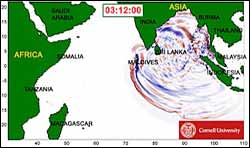Recent studies have found that large, old and oily groundfish are significantly more important than their younger counterparts in maintaining healthy marine fish stocks – the larvae from their eggs better resist starvation and have a much greater chance of survival.
These same big, old fish are also routinely sought by fisherman, scientists say, and the age decline in fish populations helps to explain the collapsing fisheries off the Pacific Northwest coast. Other research also
An unprecedented flash observed by the space shuttle Columbia crew in 2003 over the Indian Ocean may be a new type of transient luminous event, like lightning sprites, but one that is not necessarily caused by a thunderstorm. The discharge was observed less than two weeks before the shuttle was lost during its Earth reentry.
The authors describe the discharge as a Transient Ionospheric Glow Emission in Red, or TIGER, event. It was recorded by a video camera in the near-infrare
Along with Ireland and Portugal, Norway is now working to make marine research a priority focus of the 7th EU Framework Programme for Research and Technology Development (2007–2010). The goal is to develop a vital, beneficial marine and maritime economy in Europe with the help of interdisciplinary research.
Seafood, transport, security, recreation and ecology are important key words for the ocean theme in Europe. Oceans encircle a great deal of the continent. This has played a cru
Risks of underground expansion often poorly studied; modeling floods, tsunamis essential to planning
The rapid and extensive underground expansion of mega-cities – for subways, malls, parking and public utilities – takes place often with too little knowledge of associated risks and too few plans to minimize the effects of a natural disaster, United Nations University experts warn.
With growing land pressures in cities (which contain about 50% of all people today, see
The second Duke University-led expedition since 1999 to a deep underwater canyon will take geologists to another place in the eastern Pacific Ocean where new sea floor was forged out of volcanic lava within the past several million years.
The Pito Deep trough, positioned as deep as 19,600 feet below the ocean’s surface just west of Easter Island, will offer scientists a rare chance to study the internal geology of such ocean floor crust making processes.
The internal g

Cornell University researchers have created a video simulation of the deadly Dec. 26 Indian Ocean tsunami that shows in graphic detail how the massive wave system spread outward from the epicenter of an undersea earthquake northwest of Sumatra, Indonesia.
The simulation makes it clear how the tsunami struck the coastlines of Indonesia, Thailand, Sri Lanka and India with such devastating force, then continued as far as East Africa.
The video, about 7 MB, can be seen o